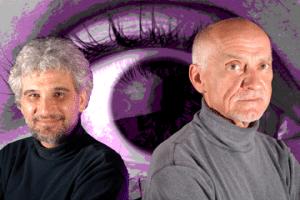Results from UH Neuroscience Workshop to Be Published as Book by MIT Press
Forum Organized by Center for Neuro-Engineering and Cognitive Science
When we look at something—when we see something—what exactly is happening in the brain? How does that activity shape conscious experience, or what scientists call the “phenomenology” of consciousness? Furthermore, as in the case of driving a car on “auto pilot,” how does visual information processing unconsciously control behavior? And finally, how does all this happen—over and over again—in an extremely small window of time: less than half a second?
Those are thorny questions for engineers and other researchers studying neuroscience, but University of Houston professors Haluk Ogmen and Bruno Breitmeyer recently gathered some of the brightest stars in the field to help define and discuss the central issues involved in understanding the time-sensitive and richly complex functioning of the human visual system and the phenomenology of perception.
The workshop was funded by the National Institutes of Health, University of Houston (UH) Division of Research, UH Center for Neuro-Engineering and Cognitive Science, Texas Learning and Computation Center, Colleges of Optometry, Liberal Arts and Social Sciences, and Engineering, as well as the Departments of Psychology and Electrical & Computer Engineering. In early 2005, MIT Press will publish results from the workshop as a book, The First Half Second: The Microgenesis and Temporal Dynamics of Unconscious and Conscious Visual Processes.
“Vision is inherently a dynamic process,” says Breitmeyer, professor of psychology. “Our eyes move three or for times a second. We have about three or four fixations a second and each one lasts about 200-250 milliseconds (ms). So what the visual system has to do in real time is construct a new representation of the visual world with each new fixation.”
When Ogmen and Breitmeyer conceived of the workshop, they took pains to invite participants that would promote the integration of previously separate areas of study, but areas that all share one common denominator: the first half second, the tiny window of time in which the fullness of vision, perception, awareness, attention, knowledge and behavior all come into play.
Why is the temporal aspect so important? For one thing, the study of when things happen in the brain turns out to be a tool in determining where things happen in the brain. “We’re tracing responses--either behaviorally or with EEG--and different epochs are associated with different levels of processing, so we can make some claims about where in the brain things are being processed by studying when they are processed,” Breitmeyer says.
The complexity of the subject matter dictates that knowledge from different disciplines be integrated.
“We can not rely on a single method,” says Ogmen. “So we got people who are using different methods, like neurophysiologists, psychophysicists, modelers. In addition, many researchers are now working in a multi-disciplinary setting, so the workshop provided a forum where there was much more exchange than you would normally have.”
The research emphasis ranged across visual sensory processing in the early and intermediate cortical levels to attention, which is a top-down mechanism that modulates activity at these lower levels, Breitmeyer says. “But the emphasis is always on the time parameter. We’re talking about an epoch that goes from zero to about four or five hundred milliseconds, so the unifying question is, how do all these mechanisms coordinate time-wise in that short time period? The system has got to be highly temporally well-orchestrated for it to work properly.”
The visual system contains both afferent (feed-forward) and efferent (feedback) connections. The feedback connections ensure that higher levels in the cortex send back information to lower levels. Neuroscientists call this “re-entrant feedback activity,” and that, it turns out, is extremely important for conscious registration and the sense of self.
“Within the dynamic systems of engineering, feedback is a very fundamental concept,” Ogmen explains. “In engineering, typically feedback is negative, meaning it’s a corrective process that stabilizes the system. But within the brain the feedback is both negative and positive.”
In engineering, positive feedback tends to make things unstable, Ogmen says. In the case of the brain, theoretical analysis suggests that this undesirable aspect of positive feedback is controlled by “reset mechanisms” that make the visual system operate in epochs of transient regimes, with each epoch lasting a few hundred milliseconds.
Ogmen and his colleagues were very deliberate in creating a smaller workshop rather than a larger conference. “The group was relatively small on purpose to allow more discussion,” he says. “In a big conference, it’s very hard to find people and find time. So we had a more relaxed setting.”
The central idea of the workshop was to open an integrated approach to the scientific community at large, to provide a synthesis, to unify the subject matter and provide a resource to someone who is new to the field, Ogmen says. “Our purpose was to put the basics together so as to allow the field to define itself and then be in a position to take off.”
The book, Breitmeyer explains, is intended to be a sampler of work being done in each of the research areas, not a comprehensive lexicon of all relevant work across every possible area. “And that was a deliberate choice on our part.”
NIH, which provided financial support for the workshop, is interested in supporting a conference on the topic in the future, Ogmen says.
Another benefit from the workshop was the chance for researchers to meet one another and possibly collaborate on future projects. “The possibilities for collaborative research doubled because of this event. It builds this extended community of mutually interested and interesting scientists that can be very fruitful.”
Read more about Professor Ogmen’s neuro-engineering research and the Center for Neuro-Engineering and Cognitive Science in the Fall 2002 issue of Parameters.
